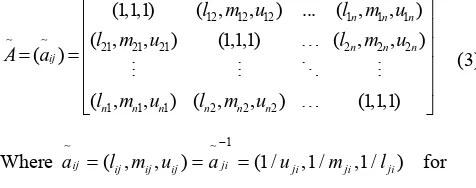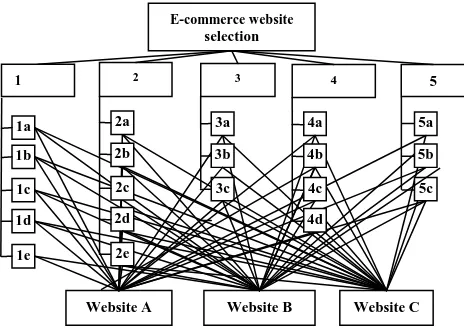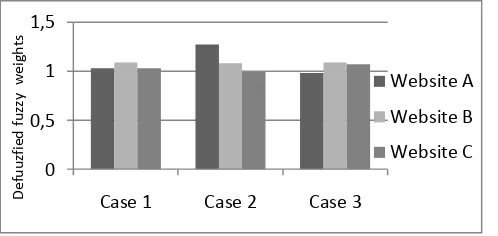Abstract— Achieving an accomplished e-commerce depends on high quality websites which are preferred by prospective customers. Assessing e-commerce website quality can be considered as a multicriteria decision making problem because of its complex structure including qualitative and quantitative factors. In this study, we propose a new methodology based on fuzzy analytic hierarchy process. The proposed methodology enables multiple decision makers on evaluation and uses triangular fuzzy scale that includes both positive and negative fuzzy numbers. The methodology includes simple mathematical calculations, and it yields triangular fuzzy numbers of alternatives’ weights. At the last step, obtained alternatives’ weights are ranked by integral values method. In the empirical study, three e-commerce websites, which are the most famous in Turkey, are evaluated by the methodology. The findings of this study shows that proposed methodology can tackle the e-commerce website quality assessing, effectively.
Index Terms— Website quality, AHP, Decision making, , Fuzzy set theory, Multicriteria decision making.
I. INTRODUCTION
Internet has provided a convenient and effective channel for distributing information and services [1]. E- commerce is clarified as buying and selling of products and services via internet. E-commerce includes buying, selling, vendor-managed inventory, production management, and logistic [2]. Recently, e-commerce has become important tool for companies all around the world. Therefore, many researcher has focused on which factors effect website quality and how to measure quality on e- commerce success. Lee and Kozar [3] investigated web quality factors on e-commerce. Lightner [4] evaluated commerce websites and focused on customer satisfaction. Torkzadeh and Dhillen [5] developed means and fundamental objectives that influence e-commerce success. Merwe and Bekker [6] developed a methodology for evaluating e-
commerce websites, and they focused on communication with customers and facilitation on business transaction. Fich
Serhat AYDIN Author is with Turkish Air Force Academy, 06770, Gölbaşı, Ankara, Turkey (corresponding author to provide phone: +90 03126126014; fax: 03126122409 e-mail: s.aydin@hho.edu.tr).
Cengiz KAHRAMAN Author is with Turkey Istanbul Technical University, Department of Industrial Engineering 34367 Macka Istanbul Turkey(kahramanc@itu.edu.tr)
[7] used systematic qualitative technique to evaluate the usability of commercial websites. Kaya [2] developed a fuzzy hybrid model to assess website in e business. Bauer and Folk [8] developed a transaction process based model scale for measuring service quality in e-service. Su and Lin [9] achieved a study of e-commerce websites in Taiwan.
There are different views in the literature on how website quality should be measured. Because of website quality measurement incorporates in both of tangible and intangible measures, it is regarded as a multi-criteria decision making (MCDM) problem. There are many methods available for solving MCDM problems in the literature. But Analytic hierarchy process (AHP), developed by Saaty [10] is one of the most practical method in the literature. The process makes it possible to incorporate judgments on tangible data as well as intangible data. AHP bases on establish pair-wise comparison matrices by using the 1-9 scale to evaluate criteria and alternatives. AHP enables decision makers to structure a hierarchy in order to select the best one among various alternatives.
In many MCDM problems, crisp data do not suffice to model real life problems. Due to shortcomings incurred by subjectivity of human judgments and vagueness of data, the fuzzy set theory, developed by Zadeh [11], can be used in decision making processes. When decision makers make pairwise comparisons in classical AHP, they may not assign crisp numerical values due to uncertain and insufficient information. Therefore classical AHP was combined with fuzzy set theory by Laarhoven and Pedrycz [12] for the first time. The most important problem of the method is related to the possibility of obtaining a normal and convex fuzzy number. The other problem of the method is that it requires cumbersome calculations. Buckley[13] used the geometrical mean method to produce fuzzy values. Chang[14] proposed a new approach involving triangular fuzzy number usage and extent analysis method for synthetic extent values of pair-wise comparisons. Cheng [15] proposed a new algorithm for evaluating naval tactical missile systems by the fuzzy analytical process [16]. Zeng et al.. [17] developed a modified fuzzy AHP for the project risk assessment.
In this study, we proposed a modified fuzzy AHP based MCDM methodology. We aimed more understandable and simple fuzzy AHP method in order to achieve measure e- commerce web site quality. In the proposed methodology, decision makers use not only positive fuzzy numbers but also negative fuzzy numbers in pairwise comparison
A Modified Fuzzy Analytic Hierarchy Process
Based Multicriteria Decision making
Methodology for Assessing E-commerce
Website Quality: A Case Study in Turkey
matrices. We used simple arithmetic operations to calculate alternatives’ importance weights.
The remainder of the paper is organized as follows: Section 2 introduces proposed model. Subsequently, a case study presented in Section 3. Sensitivity analysis is performed in Section 4. Finally, conclusions are given in Section 5.
II.PROPOSEDMETHODOLOGY
Step 1:Structure hierarchy
To start with, decision makers determine goal, criteria and alternatives of the problem in a hierarchical form. An established hierarchy has to give the whole details of information on the structure so that there should not be lack of fact about the problem.
Step 2: Make pairwise comparisons for factors
Decision makers are required to compare each factor in the hierarchy. Decision makers use the fuzzy scale shown in Table 1 to compare factors. They use experimental data, perception, background, knowledge, etc. to make comparisons. Because decision makers may have different viewpoints, they can use different linguistic variables in comparisons matrices. The weights
( )
e
are allocated to decision makers on the basis of their knowledge, experience, etc. Suppose that m decision makers exist in the group and the kth decision makerE
k is assigned an decision maker weighte
k , whereek
0,1 , e1 e2 ....em 1 .
Step 3: Aggregate individual TFNs to group TFNs
The purpose of this step is to apply an acceptable operator to get a group preference from individual preferences. The aggregation of TFNs scores is performed
by applying the fuzzy weighted triangular averaging operator, as defined by (1).
aij aij1 e1 aij2 e2 ...aijmem
(1) where aij
is the aggregated fuzzy score for Ai -
A
jcomparisons, i,j=1,2,….,n;aij1,aij2,...,aijm
are corresponding TFN scales assigned by decision makers
1, 2,...., m
E E E ,respectively. and indicates fuzzy multiplication and fuzzy addition operators, respectively.
Step 4: Convert negative fuzzy TFNs to positive TFNs.
Since the scores in the classical AHP are based on an exponential importance, we should calculate the corresponding exponential values of negative scores in our method. This conversion is obtained by (2).
(aij/ 4)
ij
a e
(2)
Where aij ( ,l m uij ij, )ij
Step 5: Calculate the priority weights of factors
Consider a triangular fuzzy comparison matrix expressed by
12 12 12 1 1 1
21 21 21 2 2 2
1 1 1 2 2 2
(1,1,1) ( , , ) ... ( , , )
( , , ) (1,1,1) ( , , )
( )
( , , ) ( , , ) (1,1,1)
n n n
n n n
ij
n n n n n n
l m u l m u
l m u l m u
A a
l m u l m u
(3)
Where
1
( , , ) (1/ ,1/ ,1/ )
ij ij ij ij ji ji ji ji
a l m u a u m l
for
, 1,...,
i j nand
i
j
Because our aim is to bring out a simplified fuzzy AHP, we avoid using a complicated normalization formula. A normalized matrix N
can be calculated as follows;
ij m n
N n
(4)
, ,
ij ij ij
ij
j j j
l m u n
u u u
(5)
max
j ij
i
u u
The normalization method clarified above is to preserve the property that the ranges of normalized triangular fuzzy numbers belong to [0,1].
And the importance weights of the factors can be calculated as follows;
1
1 1
n
ij j
i n n
kj
k j
n W
n
' k=1,2,…,n (6)
Step 6: Calculate final weights
[image:2.595.305.543.229.323.2]In this step the rating of each alternative is multiplied by the weights of the sub-criteria and aggregated to get local ratings with respect to each criterion. The local ratings are then multiplied by the weights of the criteria and aggregated to get global ratings.
TABLE 1
TRIANGULAR FUZZY CONVERSION SCALE Linguistic scale Triangular
fuzzy scale
Step7: Compare the weights using a ranking method In the last step, we rank the obtained fuzzy numbers. In order to rank the fuzzy numbers, we use the integral values ranking method developed by Liou and Wang[18] .
III.CASESTUDY
In this section, the proposed methodology was applied for assessing quality of e-commerce web sites in Turkey. There are much e-commerce websites but we assessed three websites which are the most famous. Three web designers were utilized for assessing web sites via determined criteria. The criteria were initially developed based on literature review. We used five criteria and 20 sub-criteria, which were the most suitable for assessing Turkish e-commerce websites. Different weights were assigned to three decision makers according to their experiments and academic degree in web design. The weights were 0.5, 0.25, and 0.25, respectively. Later, the four levels hierarchy was established, which contains five criteria, 20 sub-criteria, and three alternatives, shown in Figure 1. Criteria are; ease of use (1) is main criterion, and sub-criteria are completing a transaction quickly (1a), ease of navigation (1b), easy to find needs (1c), ease of online transaction (1d), easy to get different pages in website (1e). Product (2) is the second main criterion, and sub-criteria are product detail (2a), Product price detail (2b), Product quality (2c), Comment on products by customer (2d), Competitive product price (2e). Security (3) is the third main criterion, and sub-criteria are Online purchase security (3a), Protection personnel information (3b), Privacy statement (3c). And the fourth main criterion is customer relation ship, and its sub-criteria are Quick response to customer demands (4a), direction of registration(4b), Online customer service support and help (4c), Online order status tracking (4d). And final main criterion is fulfillment (5), and sub-criteria are On-time delivery (5a), Accurate delivery of products (5b), Accurate billing (5c).
Step 2: After we established the hierarchy, decision-makers evaluated all factors in the hierarchy. The comparison matrix of alternatives with respect to ‘’ease of navigation’’ as shown in Table 2.
Step 3: The aggregation of the obtained scores was calculated by (1) as follows;
21ease of navigation 0.5 (3,5, 7) 0.25(3,5, 7) 0.25 (1,3,5)
a
21ease of navigation (2.5, 4.5, 6.5)
a
Similarly other aggregates scores of the hierarchy could also be obtained.
Step 4: Then the comparison matrices which include negative fuzzy numbers were converted to positive fuzzy numbers by using (2). Table 2 was converted as follows;
21 22 23
( , , )/4
21ease of navigation l m u
a e
(2.5, 4.5, 6.5)/ 4
21ease of navigation (1.86,3.08, 5.07)
a e
[image:3.595.304.545.98.224.2]Other aijvalues of ease of navigation were givenin Table 3.
Table 3 was normalized by using (5) as follows:
21 (1.86,3.08,5.07) 5.07 (0.36, 0.60,1)
a
Similarly other normalized
a
ij values of ease of navigation were also obtained.The importance weights of the alternatives under ease of navigation were obtained by using (6). In this case, we obtained,
(0.80, 0.15, 0.30), (0.30, 0.54, 0.97),
(0.14, 0.30, 0.60)
Website A Website B
Website C
W W
W
' '
'
E-commerce website
selection
1
1a 1b 1c 1d 1e
3
3a 3b 3c
2
2a 2b 2c 2d
4
4a
5
5a
Website A Website B Website C 4c
4b 5b 5c
2e
4d
Fig. 1 Hierarchy for e-commerce website selection
TABLE 3
aijVALUES OF EASE OF NAVIGATION
Ease of
navigation A B C
A (1, 1, 1) (0.19, 0.32, 0.53) (0.25, 0.41, 0.68) B (1.86, 3.08, 5.07) (1, 1, 1) (1.28, 2.11, 3.49) C (1.45, 2.39, 3.95) (0.28, 0.47, 0.77) (1, 1, 1)
TABLE 2
COMPARISON MATRIX OF ALTERNATIVES RESPECT TO EASE OF NAVIGATION
Ease of navigatio n
Weights A B C A 0.5
0.25 0.25
(0, 0, 0) (0, 0, 0) (0, 0, 0)
(-7, -5, -3) (-7, -5, -3) (-5, -3, -1)
(-5, -3, -1) (-7, -5, -3) (-5, -3, -1) B 0.5
0.25 0.25
(3, 5, 7) (3, 5, 7) (1, 3, 5)
(0, 0, 0) (0, 0, 0) (0, 0, 0)
(1, 3, 5) (1, 3, 5) (1, 3, 5) C 0.5
0.25
(1, 3, 5) (3, 5, 7)
(-5,-3,-1) (-5,-3,-1)
[image:3.595.58.290.545.710.2]All the importance weights of the hierarchy were obtained and then synthesized. Obtained importance weights of the alternatives are as follows;
(0.19, 0.52, 2.37), (0.05, 0.38, 2.83),
(0.04, 0.35, 2.71)
Website A Website B
Website C
W W
W
After obtaining fuzzy importance weights, the last step was performed, and the fuzzy weights were ranked by integral values method. The obtained results are shown in Table 4.
IV.SENSITIVITYANALYSIS
In this section a sensitivity analysis was performed. We assigned different weights to decision makers and analyzed how much it would influence the final scores of alternatives. In the first case, the decision makers’ weights were 0.5, 0.25, and 0.25, respectively and the final scores were obtained as
(0.19, 0.52, 2.37), (0.05, 0.38, 2.83), (0.04, 0.35, 2.71)
A B C
W W W . In
the second case the decision makers’ weights were assigned as 0.1, 0.1, and 0.8, respectively and the final scores were calculated as follows
(0.20, 0.54,3.06), (0.04, 0.38, 2.82), (0.04, 0.34, 2.58)
A B C
W W W .
In the third case the decision makers’ weights were assigned as 0.1, 0.8, and 0.1, respectively and the final scores were calculated as follows:
(0.19, 0.53, 2.21), (0.05, 0.39, 2.82), (0.04, 0.36, 2.81)
A B C
W W W .
We observed that different decision makers’ weights influence final weights, and our model senses to different conditions.And Figure 2 shows sensitivity analysis results.
V.CONCLUSION
E-commerce website quality includes both qualitative and quantitative factors. Therefore, it is considered in MCDM. In this study, we proposed a modified fuzzy AHP based MCDM methodology for assessing e-commerce website quality in Turkey. We studied with three web-designers in this study for assessing all factors in the hierarchy. First of all, we developed five main criteria and 20 sub-criteria from reviewing previous studies as well as our opinions. We established a four –levels hierarchy for e-commerce website evaluation. We got alternatives’ weights by using our methodology. The proposed methodology has many advantages. The methodology enables decision makers to use not only positive fuzzy numbers but also negative fuzzy numbers in order to evaluate hierarchy. It uses more understandable scale to compare factors. And it uses simple mathematical calculations to get importance weights. And it follows the steps of the traditional AHP.
We point out that the proposed methodology in this study can handle the problem effectively and efficiency. For further research, other MCDM techniques such as fuzzy VIKOR, fuzzy ANP, fuzzy PROMETHEE can be used and their results can be compared with the proposed methodology.
REFERENCES
[1] Kim, D. J., Kim, W. G., and Han, J. S., ‘‘A perceptual mapping of online travel agencies and preference attributes’’, Tourism Management, vol. 28, no 2, pp. 591–603, 2006.
[2] Kaya, T., ‘‘Multi-attribute Evaluation of Website Quality in E-business Using an Integrated Fuzzy AHP TOPSIS Methodology’’,
International Journal of Computational Intelligence Systems, vol. 3,
no 3,pp. 301-314, 2010.
[3] Y. Lee and K. A. Kozar, ‘‘Investigating the effect of website quality on e-business success: An analytic hierarchy process (AHP) approach’’, Decision Support Systems, vol. 42,pp.1383–1401.,2006. [4] Lightner N., ‘‘Evaluating E-Commerce functionality with a focus on
customer service’’, Communications of the ACM. Vol. 47,no. 10, pp. 88–92, 2004.
[5] Torkzadeh G., Dhillon G., ‘‘Measuring factors that influence the success of Internet commerce’’, Information Systems Research, Vol.
13, pp.87–204, 2002.
[6] Van der Merwe R., Bekker, F., ‘‘A framework and methodology for evaluating ecommerce websites, Internet Research’’, Electronic Networking Applications and Policy, vol. 13, no. 5, pp. 330–341,
2003.
[7] Benbunan-Fich, R., ‘‘Using protocol analysis to evaluate the usability of a commercial website’’, Information and Management, vol. 39,pp.
151–163, 2001.
[8] H.H. Bauer, T. Falk, M. Hammerschmidt, e TransQual: A transaction process-based approach for capturing service quality in online shopping, Journal of Business Research 59 (7), 2006, pp. 866–875. [9] Harison E., Boonstra A., ‘‘Reaching new altitudes in ecommerce:
Assessing the performance of airline websites’’, Journal of Air Transport Management, vol. 14, 92–98, 2008.
[10] Saaty, T. L., The analytic hierarchy process. New York:
McGraw-Hill, 1980.
[11] Zadeh, L. A., ‘‘Fuzzy sets’’, Information and Control, vol. 8, pp. 338–353, 1965.
[12] P.J.M. Laarhoven and W. Pedrycz, ‘‘A fuzzy extension of Saaty’s priority theory’’, Fuzzy Set Systems, vol. 11, pp. 229–41, 1983.
TABLE 4
RANKINGOFTHEALTERNATIVES
Websites I(ω) Comparison
A-B 0.49 B> A
B-C 0.51 B > C
A-C 0.51 A > C
0 0,5 1 1,5
Case 1 Case 2 Case 3
Website A
Website B
Website C
Def
uuz
fi
ed
fu
zzy
we
ig
h
ts
[image:4.595.47.296.596.714.2][13] Buckley J.J., ‘‘Fuzzy eigenvalues and input–output analysis’’, Fuzzy Set Systems vol. 34, pp. 187–95, 1990.
[14] Chang D.Y., ‘‘Applications of the extent analysis method on fuzzy AHP’’, European Journal of Operational Research, vol. 95, pp.649– 655, 1996.
[15] Cheng C.H., ‘‘Evaluating naval tactical missile systems by fuzzy AHP based on the grade value of membership function’’, European Journal of Operational Research, vol. 96, pp. 343–350,1996.
[16] Aydin, S., Kahraman, C., ‘‘Multiattribute Supplier Selection Using Fuzzy Analytic Hierarchy Process’’, International Journal of Computational Intelligence Systems vol. 3, no. 5, pp.553-565, 2010.
[17] Zeng. J., Min, A., Smith, N.J., ‘‘Application of fuzzy based decision making methodology to construction Project risk assessment’’,
International Journal of Project Management, vol. 25, pp. 589-600, 2007.
[18] Liou T.S., Wang, M.J., ‘‘Ranking fuzzy numbers with integral value’’, Fuzzy Sets and Systems, vol. 50, pp. 247-255, 1992.


